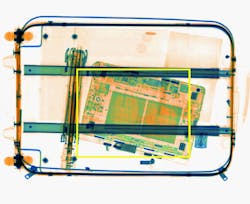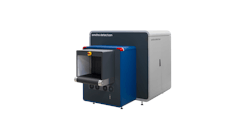The Shifting Security Landscape: Digital Technologies are Changing the Face of Airport Checkpoints for the Better
Airport security threats are highly complex and ever changing. Navigating these threats is increasingly challenging when seeking to deliver enhanced passenger experience. In the U.S., as with Europe, there has been a rapid rebound in travel demand as lockdowns lift and restrictions ease. This spike in passenger numbers, combined with capacity constraints, staff shortages and the evolving nature of security threats, mean that U.S. airports, alongside many around the world, face increasing amounts of pressure.
Security of course can never be compromised, and controls must remain in place. However, as with every industry, digital transformation has an essential role to play in ensuring effective operations as well as future proofing for emerging threats and evolving regulation. Digital technologies for aviation security are now progressing at pace and there are readily available solutions – with many on the horizon – that harness data, automation and connectivity to drive efficiencies whilst delivering a great passenger experience. Responsible approaches and industry standards must be adhered to, and in some cases agreed upon, for new digital technologies to ensure the maximum safety of aviation security networks and the opportunities presented by these technologies can be seized.
Cutting Queues with CT
Computed tomography (CT) technology is an immediately available solution that delivers a multitude of benefits to the airport screening process. Originally developed for the medical sector, CT-based scanning produces high definition, 3D rotatable imagery, which reduces overall screening time and allows operators to make more accurate assessments, minimizing false alarm rates, touch points and unnecessary interaction between passengers and screeners.
When deployed at the checkpoint, operators can inspect baggage in detail, from every angle. This removes the need for passengers to take out electronics and liquids from their bags, which significantly reduces the burden of the screening process on both operators and passengers, whilst speeding it up and cutting queue times. With the reduced need for operator involvement, CT scanning enables checkpoint operations to work more seamlessly with fewer analysts – which is a crucial benefit for airports, especially those facing recruitment challenges.
CT scanners are being adopted by airports around the world and will eventually become the norm, which is great news for passengers. Regulators are encouraging the adoption of CT enabled X-ray scanners, with some setting deadlines for its introduction. In the UK, the latest generation of EDS CB C3 approved CT scanners must be installed in all airports by 2024. In the U.S., the Transportation Security Administration (TSA) has rapidly rolled out CT technology, having already installed over 300 Smiths Detection HI-SCAN 6040 CTiX scanners, which were delivered within one year, during the pandemic. Airports equipped with CT scanners are reaping the benefits – with fewer items needing to be removed from luggage, and therefore fewer trays used. Passenger throughput has been significantly boosted versus conventional scanning systems, which is crucial for managing peak times and preventing delays.
The efficiency benefits of CT scanners can be further enhanced when combined with automated screening lanes. The first airport in the U.S. to introduce an automated screening lane (ASL) with CT technology, coupled with remote screening, was George Bush Intercontinental Airport (IAH) in Houston, in Terminal D. This was made possible through TSA’s facilitation program – the Accessible Property Screening System (APSS) program - which it utilizes to test and procure solutions outside the TSA’S Qualified Product List (QPL) in the field. Six of Smiths Detection’s HI-SCAN 6040 CTiX scanners were deployed in Terminal C in 2018, with United Airlines procuring midsize ASLs through TSA’s gifting program to create a full-sized Checkpoint Property Screening System (CPSS). The installation of the CTiX scanners, completed within just one year, has increased throughput drastically – at an average rate of approximately 200 passengers per hour and 330 per hour during peak times. Not only has this boosted operational efficiency, but has resulted in cost savings, as IAH was able to close the security checkpoint at Terminal E earlier than planned for its renovation, with Terminal C having greater capacity for passengers.
Screening at a Distance
Whilst CT scanners are increasingly adopted, centralized networking or remote image evaluation represents a newer frontier. Typically deployed for hold baggage screening systems, remote screening is not yet widely used for airport passenger checkpoints. However, it promises significant efficiency benefits for major airport hubs which deal with large passenger traffic.
With centralized image evaluation, X-ray images taken from across an airport are sent to analysts based in a remote location away from the busy checkpoints – allowing operators to make faster and more accurate decisions to divert scans which require further inspection and bag searches. This helps with creating a smoother flow through the checkpoint and prevent the build-up of queues.
A key benefit of centralized networking is ‘multiplexing,’ which enables a flexible ratio of operators to security lanes so resources can be optimized to meet demand and operational objectives. Networked images are collected from all security lanes across the airport and delivered to the next available operator – making more efficient use of staff resources as images from both quiet and very busy lanes are distributed equally. Multiple operators can examine X-ray images simultaneously, removing the need to pause conveyor belts during the inspection process and ensuring the most efficient use of equipment. Staff could also be deployed more flexibly and moved between different locations depending on whether there are busy peaks, delivering significant cost efficiencies.
The networking concept can be applied to groups of nationwide airports, linking hundreds of checkpoints to a central analysis facility. Smaller airports could become part of one network with all image analysis handled off-site – and international networking is also possible.
The Next Big Disruptor: Open Architecture
As digital networked solutions for aviation security advance, airport security systems will naturally become more connected. However, connectivity is predicated on the interoperability of systems – more simply put, the ability of systems and platforms of different vendors to ‘talk’ to one another. This is open architecture (OA).
The integration of different vendor devices such as tray return systems and X-ray equipment into one intelligent system is already an established feature at many airports, and the use of open data formats, such as the Digital Imaging and Communication in Security (DICOS) standard, will in time allow the import and export of X-ray images and other relevant data from a range of different equipment.
OA also allows security authorities to incorporate new security and technology components into their screening systems through ‘standard interfaces,’ which means different systems can work in tandem. With OA, different fleets can be enhanced with the most up to date software to take advantage of new technologies, such as AI, to boost security outcomes and meet new security threats and regulations. Indeed, a more integrated and open network of security systems would enable airports to share richer data insights more easily and more effectively collaborate to detect security threats.
Manufacturers, such as Smiths Detection, are actively engaging with airports, regulators, and other aviation industry stakeholders in various projects to inform the development of a common set of standards to ensure that OA can be deployed in a way that maximizes its benefits and does not compromise screening data or system effectiveness. This includes exploring how ‘open’ open architecture systems should really be to allow for flexibility, as well as how combinations of screening systems with algorithms would be certified, compliant and cyber secure. Close industry collaboration will be key to ensuring open architecture platforms operate safely and compliantly.
Protecting that which Protects
With an increasing move towards data-driven solutions, remote processes and enhanced connectivity to improve efficiencies, there is a greater risk of cybersecurity vulnerabilities and attacks. As set out by IATA’s report, Air Transport 2040 and Beyond, cyber threats are likely to grow in sophistication, with the potential to compromise entire aviation networks. It is critical that the systems underpinning the global aviation network are secured to the highest level. Across aviation security systems, there is a vast amount of sensitive data that is collected, from hold baggage screening (HBS) devices to passenger and carry-on baggage scanners – and it is critical that this data is not compromised, whether intentionally or unintentionally.
With networked solutions however, cyberthreats increase. Using the example of airports increasingly deploying third-party, AI-enabled algorithms to unlock the benefits of automatic detection capabilities – from boosted security outcomes, enhanced operational performance and cost efficiencies. These algorithms are fed with data shared through OA, and potentially via the cloud. Open interfaces with third parties could reduce a screening system’s overall robustness to a cyber threat, if a responsible approach to implementation has not been adopted.
It is best practice to adopt a holistic approach to cybersecurity, developing policies and a culture that incorporates hardware, people, processes and technology. Cybersecurity measures must be bespoke – and ultimately rooted in a thorough assessment of an airport’s operational risks and compliance requirements. The truth is, it will be an ever-evolving job, with protocols and processes requiring constant review to make sure they are fit for purpose and meeting the requirements of the changing regulatory landscape. This makes it all about getting the frameworks and foundations in place – to maintain the agility required to tackle threats effectively.
Creating the Airport of the Future
Aviation security solutions are being shaped by data, connectivity, and automation – and we are beginning to see technologies that will create the airport of the future come onto line. After a challenging summer for the sector, it has never been more important to boost the appeal of aviation as a transport of choice. With an increasing shift towards digital, it is universally acknowledged that new risks open up. However, robust cybersecurity frameworks have been developed – and just as attacks will become more sophisticated, so will these frameworks. To fully realize the potential opportunity for a more integrated, data-driven and secure checkpoint, industry collaboration will be vital. There can be no crystal ball predictions, but with increasing innovation across airport checkpoints in the U.S. and globally, the path to greater efficiency and a better passenger experience is being laid.
Matt Regan has over 20years in the aviation industry, and has spent the last 13 years at Smiths Detection providing X-ray detection security services to U.S. Department of Homeland Security agencies such as TSA and U.S. Customs and Border Protection.



